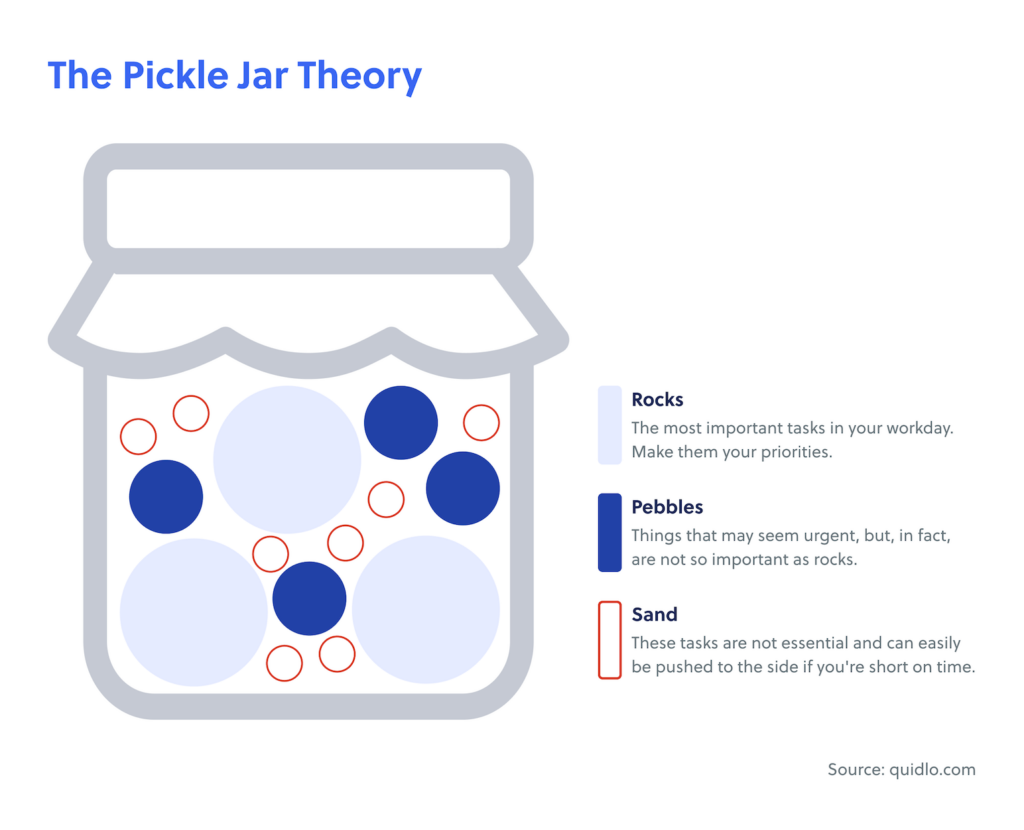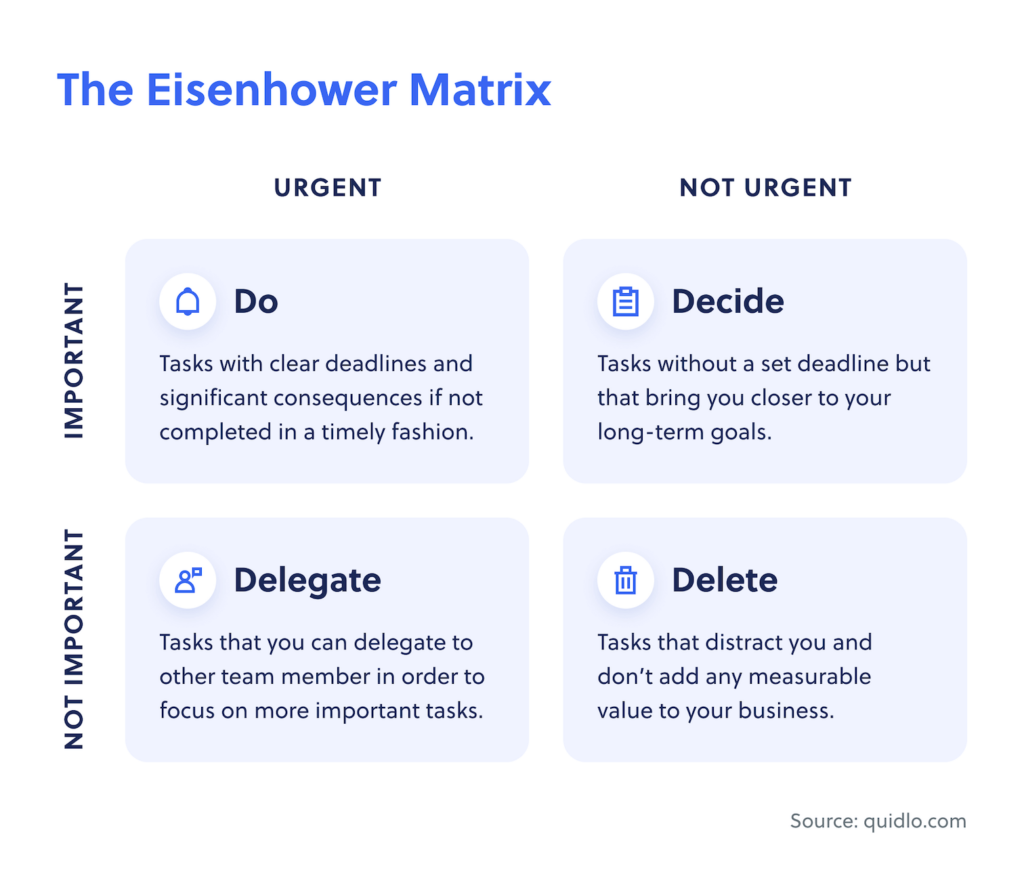You’re probably wondering what on earth a pickle jar has to do with time management.
The answer is: a lot.
It’s symbolism, really. But worry not, at Quidlo, we’re going to tell you everything you need to know about how a pickle jar can help you take control of your time so you can get more out of each day.
Ready? Let’s stick our hand in the jar and find out…
Table of Contents
What is The Pickle Jar Theory?
The Pickle Jar Theory (also known as The bucket of rocks theory or The jar of life theory) is a simple but effective way to visualize and manage your time. The idea is that, like a pickle jar, your time is limited – so you need to determine what’s important and what’s not in your day-to-day, since you can only fit in so much.
It was coined in 2002 by author Jeremy Wright. Here’s how it works:
You have a jar (or, if you’re not into jars, any container will do) and you fill it with all the tasks that you need to do in a day. The size and importance of your tasks are represented through four elements: Rocks, pebbles, sand, and water.
- The rocks: Say hello to the most important tasks in your workday. These to-dos will be bigger than others, so they’ll take up more space in the jar (more time). Make them your priorities.
- The pebbles: The pebbles are second in line when it comes to importance. They’ll take up less space than the rocks but more than the sand or water. You should still make time for them, but they’re not as pressing as your top priorities. Think: phone calls, emails, meetings – things that may seem urgent, but, in fact, are not so important as rocks.
- The sand: Sand represents the smaller tasks that you might need to do in a day, such as checking social media or taking a coffee break. These tasks are not essential and can easily be pushed to the side if you’re short on time.
- The water: The water is, essentially, your private life – the things you need to do for yourself, such as eating, sleeping, and spending time with family and friends. Like sand, these tasks are not essential to your workday, but they’re important nonetheless.

The key is balance. The large rocks would not fit if you put the water and sand in first, then your pebbles (AKA prioritizing the wrong things). At the same time, if you tried to just put in 10 large rocks, they’d break the jar (AKA biting off more than you can chew with critical tasks).
The goal is to fill your jar with as many rocks (important tasks) as possible before moving on to the pebbles, sand, and water. Once the jar is full, that’s it. You can’t add any more tasks.
Examples of The Pickle Jar Theory: Using the technique in real-life.
Now that you know the basics of The Pickle Jar Theory, let’s take a look at how it can be used in different areas of your life.
Using the Pickle Jar at work:
Let’s say you’re a project manager and you have a team of 10 people working under you. In a typical day, you might have 30 tasks on your to-do list, ranging from checking in with team members, attending meetings, to working on project proposals.
Before you even start your day, take a few minutes to sit down and visualize your tasks as rocks, pebbles, sand, and water. What are the most important things you need to get done? These are your rocks. Make a list of them and put them in order to review project progress to attend meetings.
Your rocks as a project manager might be:
- Reviewing project progress with team members
- Attending client meetings
- Working on project proposals
Once you’ve identified your rocks, it’s time to start filling up your jar. You’ll probably find that you can only fit in 2-3 rocks before you need to move on to the pebbles. That’s okay. The goal is to get as many rocks in as possible, not to fill the jar to the brim. Your pebbles then might be:
- Checking in with team members
- Answering emails
- Scheduling calls
Sand:
- Checking social media
- Taking a coffee break
- Reading industry-relevant news
These are all tasks that can easily be pushed to the side if you’re short on time. And so on. You can continue this process until your jar is full – or until you’ve run out of time.
Using the Pickle Jar at home:
The Pickle Jar Theory can also be used at home to help you manage your time more effectively. Let’s say you have a list of chores to do around the house, ranging from doing the laundry to mowing the lawn to taking out the trash.
As with work, start by identifying your rocks – the most important tasks that need to be done. In this case, your rocks might be:
- The kids (picking them up from school, helping them with homework, etc.)
- Making dinner
- Doing the laundry
Once you’ve got the big tasks out of the way, you can move on to the pebbles, sand, and water. These might be tasks like:
- Mowing the lawn
- Taking out the trash
- Washing the dishes
Again, the goal is to get as many rocks in as possible before moving on to the less important tasks.
Advantages of The Pickle Jar Theory
You might be wondering why you should bother with the Pickle Jar Theory when there are so many other time management techniques out there.
Here are a few advantages of this technique:
- It forces you to prioritize: When you sit down and visualize your tasks as rocks, pebbles, sand, and water, you’re forced to think about what’s most important and why that is. This can help you stay focused, boost performance, and avoid getting sidetracked by less important tasks.
- Know how your time is spent (so you can plan your day much better): Over time, you’ll develop a better idea of how long certain tasks take throughout the day (made even easier with an online time-tracking app). When you know how long your “rocks of the day” might take, you can budget your time more effectively and avoid spending too much time on certain tasks – like the pebbles and sands.
- It’s flexible: The great thing about The Pickle Jar Theory is that it can be applied to any area of your life – work, home, school, etc. You can also adjust it to fit your needs. For example, if you only have a few minutes to spare, you can focus on getting the pebbles done. Or, if you have a few hours to spare, you can focus on getting the rocks and pebbles done.
- Prevents multi-tasking and procrastination: Since you can only work on one task at a time, you’re forced to focus on each task individually, which can help you get more done in less time. Additionally, since you’ve clearly defined the most important tasks first (the rocks) and allocated a set amount of time towards everything, you’re less likely to procrastinate according to Parkinson’s Law.
- It’s simple: The Pickle Jar Theory is a very simple technique that anyone can use. You don’t need any special tools or training – just a clear understanding of what’s most important to you.
Disadvantages of The Pickle Jar Theory
Of course, no time management technique is perfect – and The Pickle Jar Theory is no exception. Here are a few disadvantages of this technique:
- You might not get everything done: Since you can only work on one task at a time, it’s possible that you won’t be able to complete everything on your list. This is especially true if you have a lot of tasks to get done.
- It’s easy to get sidetracked: Since the tasks are clearly defined, it can be tempting to focus on the less important tasks first (the pebbles and sand). This can cause you to lose sight of your goals and waste time on tasks that aren’t really that important.
- It might not work for everyone: The Pickle Jar Theory might not be suitable for everyone. For example, if you’re a creative person who likes to work on multiple projects at the same time, this technique might not be for you.
How to Implement The Pickle Jar Theory in Practice: The Step-by-step
If you want to use the pickle jar theory in your life successfully, you need to order your day-to-day activities properly. Your jar will get full pretty fast if you fill it with sand and pebbles like chatting with colleagues or social networking, and other urgent tasks that can wait. Next thing you know, you can’t put the rocks in your jar – AKA the most important activities during the day.
So you end up being unproductive – even if it seems like you “got a lot done.”
To make your day more productive, fill your “jar” with the most important tasks first. And in the end, deal with the menial stuff. Here’s how to get started:
- Start with the tasks that move the needle: As we mentioned earlier, it’s important to start your day by focusing on the most important tasks (up to 4 items). How do you determine the “important” tasks? They should be the activities that will have the biggest impact on your life or business. For example, if your goal is to grow your business, then your “rocks” might be tasks like developing a new marketing campaign or working on a new product. On the other hand, if your goal is to get healthy, then your “rocks” might be things like going for a run or preparing healthy meals.
- Create a to-do list and set a time limit for each task: A project timeline can be a great way to stay organized, focused, and avoid procrastination. When creating your to-do list, be sure to include both your “rocks” and “pebbles” and set a time limit for each task. This will help you stay on track and avoid spending too much time on any one thing.
- Tackle the hardest tasks first: Once you’ve identified your “rocks”, it’s important to tackle the hardest rock first (also known as the “eat the frog” technique). Why? Because they’re usually the most important tasks (and the ones that will have the biggest impact). And by getting the hard stuff out of the way first, you’ll be less likely to put your day off.
- Set a timer and start working: If you’re struggling to make the pickle jar theory work, it could be because you’re not accurately estimating the time behind your tasks. So once you’ve identified your “rocks” and created a to-do list, it’s smart to set a timer and get to work. Quidlo, for example, can track how long you and your team’s tasks take with the click of a button and give you an overview of how your time is being spent across all your to-dos.
- Delegate some tasks: If you have a lot of pebble and sand tasks to get done, it might be helpful to delegate some of them to others. This can help reduce your workload and allow you to focus on the most important tasks. But, keep in mind that not everything should be delegated. For example, if you have a meeting – you may want to attend, otherwise, you may miss important details or even come off as careless or uninterested to the other party.
This way, you’ll handle your most important tasks first, then the rest. Remember that highly productive people use their resources efficiently – they don’t care how much they did, but what they did.
But, it’s important that you don’t forget about the water (family and private life). If you fill your jar with work-related tasks and don’t leave any time for your loved ones, you’ll quickly find that your life is out of balance. We all need a supportive and relaxed environment to grow and develop in all aspects of our lives.
The Pickle Jar Theory Implementation Time Management Techniques
So while The Pickle Jar theory helps you identify what you need to get done, there are a few different time management techniques you can use to effectively get the actual work done. Here are a few of the most popular techniques:
- The Pomodoro Technique: The Pomodoro Technique is a time management technique that was developed in the 1980s by Francesco Cirillo. It’s based on the idea that we can all work for 25 minutes at a time before taking a 5-minute break. After four 25-minute work periods, you take a longer break (15-30 minutes). To use the Pomodoro Technique, you’ll need a timer and a notepad. Set your timer for 25 minutes and start working on your task. Once the timer goes off, take a five-minute break. During your break, you can do something mindless like checking Facebook or taking a walk. After four work periods, take a longer break (15-30 minutes).
- The Eisenhower Matrix: The Eisenhower Matrix is a time management technique that was developed by President Dwight D. Eisenhower. The Eisenhower Matrix is based on the idea that we can all work on tasks that are important and urgent, important but not urgent, not important but urgent, or not important and not urgent – these four defined quadrants are a great way to look at how you’ll be choosing your rocks, pebbles, sand, and water.
- The Ivy Lee Method: The Ivy Lee Method is a time management technique that was developed in the early 1900s by Ivy Lee. The Ivy Lee Method is based on the idea that we should all create a to-do list at the end of each day, with the most important tasks (rocks) listed first. Then, we should work on the most important task until it’s complete before moving on to the next task.

Don’t forget these pro tips for implementing The Pickle Jar theory:
- Don’t try to do too much at once. Focus on one task at a time and give it your full attention.
- Don’t underestimate the time it will take to complete a task. It’s better to overestimate the time you’ll need than to underestimate it and find yourself stressed out later (again, a time-tracking app can help you make more accurate and reasonable time estimates so you don’t have trouble with this).
- Take breaks frequently. Our brains can only focus for so long before we need a break. Get up and walk around or do something mindless for a few minutes to give your brain a break.
- Start small. Don’t try to completely overhaul your schedule all at once.
- Start with one area of your life (like work) and make changes there first. Then, once you’ve got a handle on that, you can move on to other areas.
The Pickle Jar theory is a great way to manage your time and prioritize your tasks. By filling your jar with the most important tasks first, you can make sure that you’re always making progress on the things that matter most to you. And by taking breaks frequently and starting small, you can make The Pickle Jar theory work for you.
The takeaway from all of these time management techniques is that we need to be aware of how we’re spending our time in order to make the most of it. And, once we’ve identified what’s important, we need to work on those tasks first. The pickle jar theory is a great way to help you do just that.
Track your rocks and pebbles like a pro with Quidlo
While you may have started this blog post wondering what on earth a pickle jar has to do with time management, hopefully, you’re ending it with a much better understanding. Remember it’s about the big rocks, pebbles, sand, and water.
So ask yourself: what are your big rocks? What are the most important tasks that you need to complete? Put those in your jar first, and then work on them until they’re done. And don’t forget to take breaks frequently so you can recharge and refocus. With these tips, you’ll be well on your way to mastering the pickle jar theory time management technique.
And if you’re struggling to meet your time commitments for your main tasks, consider trying out a time-tracking app like Quidlo (for free) to get a better idea of how your time is being spent, remove bottlenecks, and become more productive.
Cheers!







